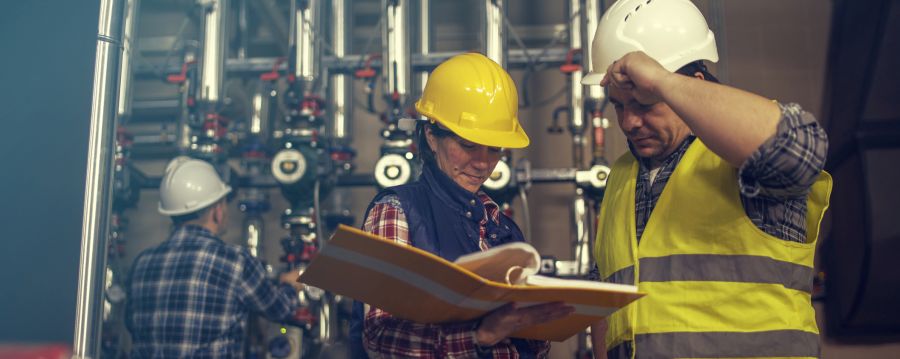
Safety Risk Assessment Part 2: Do a Walkthrough

Before you can begin to create a safety program for your business, you need to understand what challenges you face. That means doing a full safety assessment. In Part 1 of this article, you learned about the importance of gathering the information you already have. Now it’s time to stretch those legs on a safety walkthrough to see for yourself what safety challenges are out there.
Put Together a Safety Team
Before you start your walkthrough, put together a small safety team. Try to get representatives from each area of your business. Having a dedicated safety team helps in several ways:
- Each representative can give you insight into their work area.
- More eyes catch more trouble spots.
- They can become leaders in their departments, promoting a safety culture throughout the facility.
- Having a team allows you to delegate and create accountability.
Tour the Facility
Get the team together, grab some clipboards, and plot out your walkthrough route. You want to make sure you hit every part of your business because safety issues can be hiding anywhere. As you walk, look for safety issues throughout your facility. You might want to give each person on your team a specific safety category to focus on. Have your team look for hazards in the following areas:
General housekeeping
Are work areas kept tidy and free of clutter? Are things organized so that tools can easily be found when needed and stored safely away when not used? Misplaced items, wet floors and other sloppy habits can easily lead to injuries. Establishing good housekeeping standards and practices can go a long way towards promoting a safe work environment.
Slip, trip, and fall hazards
Slips, trips, and falls are some of the most common workplace injuries. Look for areas where the floor might be wet or slick. Are walkways clear? Look at any situations where employees will work at an elevation of 4 ft or more and consider what safety precautions need to be in place. Are ladders in good shape? Is scaffolding properly assembled? Sometimes little things like a door threshold that sticks up a little can be an accident waiting to happen.
Electrical hazards
Electricity makes much of our work possible, but it brings with it certain dangers. Look for common electrical hazards such as overloaded outlets, exposed wiring or electrical wiring or equipment in areas with moisture. These can create deadly situations, but are usually easy to fix. Areas with high amounts of electricity should be clearly marked.
Equipment operation
As you move through the facility, watch as workers use various types of equipment. Are they following established protocol? Do they seem confident that they know what they are doing? Does the equipment operate smoothly? Look for signs of frustration as that can be an early indicator that equipment is either not working properly or the operator is not fully trained in its operation.
Equipment maintenance
Is equipment in good working order? If you see someone working on a machine, do they follow proper lockout/tagout procedures? Poorly maintained equipment and unsafe maintenance procedures are accidents waiting to happen.
Fire protection
Do you have the proper fire safety equipment such as fire extinguishers? Are their locations clearly marked? Are smoke detectors and emergency lights in working order? Are all fire exists clearly marked and free of obstacles?
Work organization and process flow (including staffing and scheduling)
You can’t tell everything just by walking by and looking, but you can tell when a department is understaffed or scrambling to get their work done. Look for areas that seem overtaxed or in confusion. If you’re not sure what you’re seeing, ask a worker.
Ergonomic problems
Many injuries are not caused by a sudden violent action, but the constant, repetitive work done with poor ergonomics. Look for poor posture caused by chairs or tables of improper height. Are people overextending themselves repeatedly to reach for items they need? These are easy fixes and can not only help avoid injury, but make employees enjoy their jobs more on a daily basis.
Lack of emergency procedures
Do you see emergency procedures such as fire evacuation routes clearly posted? Quiz employees you see on your walkthrough to see if they are aware of different emergency procedures for specific scenarios like bad weather, fire, or a chemical spill.
Three Major Hazard Categories
While all of these categories are important, as you complete your walkthrough, keep in mind the three major categories that cost employers the most when it comes to workplace injuries and OSHA citations are:
- Slips, trips, and falls
- Machine injuries
- Personal Protective Equipment
Locate your problem areas and come up with a plan and a schedule for mitigating any safety issues. As you walk through, don’t forget to talk to the employees who work in each area. They are an invaluable source of information!
The final step
The final step is to develop a plan to make this a regular part of your safety program. Create a schedule to complete this walkthrough periodically. Things change in the workplace, and you want to identify and address new hazards as quickly as possible.
Once you have identified any hazards in these areas, address the problems quickly.

